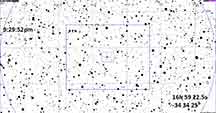

This is a decent rank event, long duration of 9 sec, 17 alt in Scorpius, but the path requires driving south to Paicines area or Monterey area / Salinas.
 |
 |
At the last minute, after a beach run, I was in an adventurous enough mood to go for it - I called Kirk and he met me at 7:25pm at my place, we packed our gear into my RAV4, and off I drove to get to the path near Tres Pinos. Traffic was baaad, with road work at various places, but I got Kirk set at a side road north of Tres Pinos, then I drove to Panoche Rd and along it for 1.9 miles to set up at an vineyard field access road at a locked gate. Skies were clear, no fog in the San Benito valley at this time. We got recorded data, but first look says a miss. That's remarkable, since I was near the centerline with nominal odds of a hit of 98%. Kirk too had a miss. We'll study further before reporting.
I set up on Panoche Road 1.9 miles from the little store at Paicines. The locked gate there seemed like a perfect turn out to observe from. I didn't have time to search around elsewhere, but it became clear that there were a lot of tractors and other Ag tractor-like objects moving around in the vineyard there. They took no notice of me. It was a bit spooky, like those alien-controlled farm equipments in the film "Interstellar". One came down the road that terminated at the gate I was on the far side of, and the light blinded my scope and Watec, seen below. It was well before the predicted occultation, but I had to manually trim out the data from the raw file. It turns out that PyOTE will not do an automatic block integration determination from the file once you specify which points to left/right trim. Strange.
The other strange thing going on, was the bright unexpected star above the target, which confused both Kirk and I for a bit, till we just had to accept it was different in brightness than C2A and UCAC4 expected. Probably a long period variable star is my guess. More rarely, a nova?
The last image below shows fairly convincingly that it was a miss. I integrated at 16x, 8 dots per integration. I was "Maley'd!" (Paul Maley's been geting, it seems, more than his share of being on the predicted centerline of good rank evens and still seeing a miss. So, "Maley" is now a verb!
|
Here is the SDSS photograph of the target area. Notice that to the left of "star 1" there is no comparable bright star. |
Here is the same area, but taken from my video. There is clearly a star much brighter than on the photo. A variable star? |
A tractor headlight went straight down my telescope tube and so blinded my camera that it couldn't read time stamps, and scrambled everything. I had to edit the file and eliminate all the data before this event passed. |
The PyOTE light curve of the good data. There was also some lost data after the light curve shown here, due to having to move the scope to keep the target star from hiding among the time stamp numerals. The expected duration and depth is shown. A miss, is the verdict. |
 |
 |
 |
 |
No deep disappearance like we expected. A miss. Target light curve in gold in first frame below. PyOTE calibrated, also finds no event. So, we both had a miss. Strong south shift?
 |
 |
 |